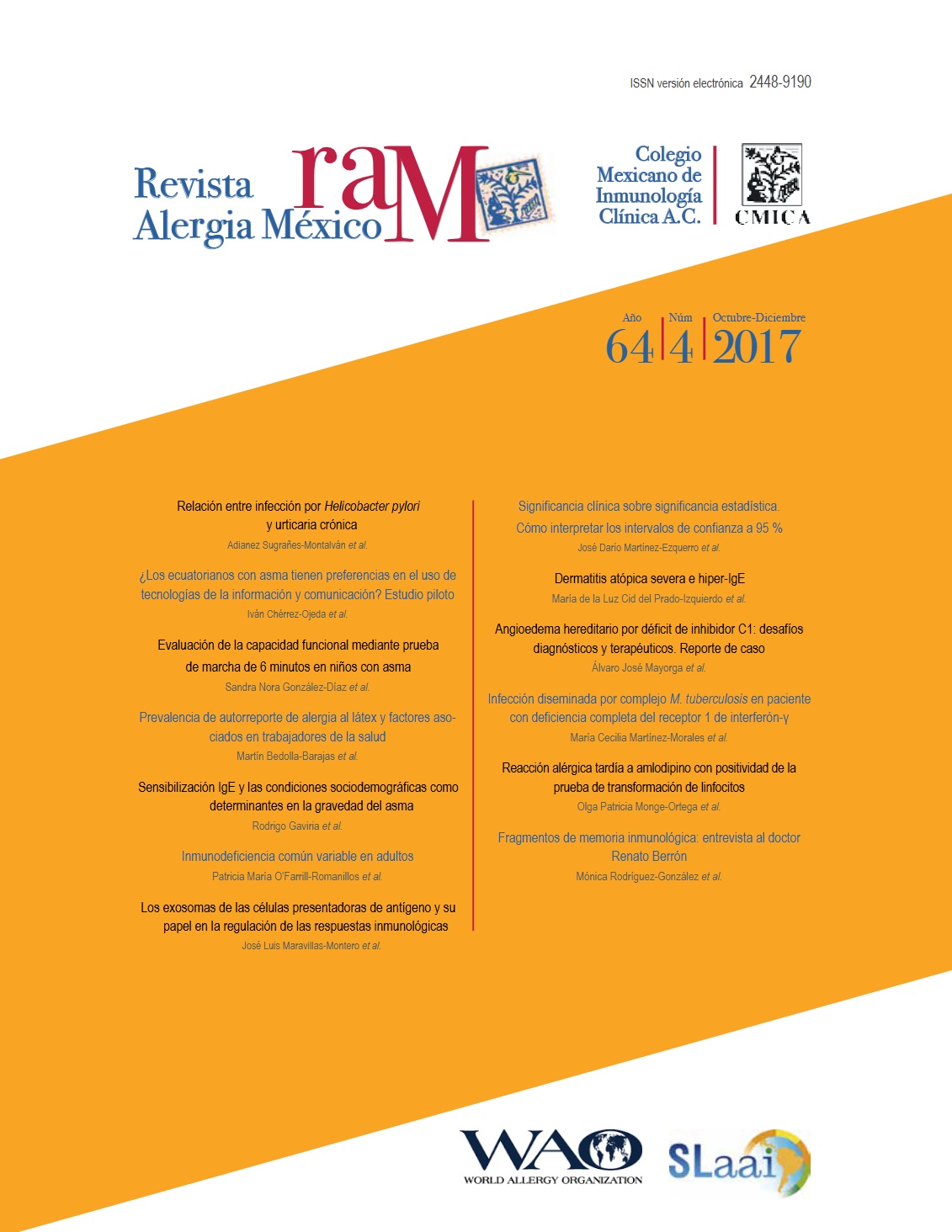Resumen
Antecedentes: el angioedema hereditario es una enfermedad que se manifiesta con episodios de edema espontaneo, de piel, mucosas y vía aérea. Su tratamiento se centra en las crisis y en la profilaxis para minimizar el número y severidad de estas. En diversas partes del mundo, los derivados de andrógenos, antifibrinolíticos y plasma fresco congelado son los recursos disponibles para la profilaxis.
Caso clínico: adolescente de 16 años sin antecedentes personales ni familiares, quien en el transcurso de 1 año presentó episodios recurrentes de angioedema indoloro, no pruriginoso; no respondió a antihistamínicos, corticosteroides o adrenalina, por lo que se aplicó plasma fresco congelado en una ocasión, que inmediatamente exacerbó la severidad del episodio. Se retrasó el diagnóstico porque no se disponía del estudio en el país, el cual fue enviado al extranjero donde se confirmó el déficit del inhibidor C1 (7.1 μg/mL). Se inició tratamiento profiláctico con danazol, con respuesta favorable y posterior disminución en el número de episodios.
Conclusión: el retraso diagnóstico implica riesgo considerable en estos pacientes; la importancia del tratamiento profiláctico a largo plazo se ratifica en el uso de andrógenos, opción al alcance de los países en desarrollo.Referencias
Betschel S, Badiou J, Binkley K, Hébert J, Kanani A, Keith P, et al. Canadian hereditary angioedema guideline. Allergy Asthma Clin Immunol. 2014;10(1):50. DOI: http://dx.doi.org/10.1186/1710-1492-10-50
Henao MP, Kraschnewski JL, Kelbel T, Craig TJ. Diagnosis and screening of patients with hereditary angioedema in primary care. Ther Clin Risk Manag. 2016;12:701-711. DOI: http://dx.doi.org/10.2147/TCRM.S86293
Dulfary-Sánchez M, Cuervo J, Rave D, Clemen G, Yepes-Núñez JJ, Ortiz-Reyes B, et al. Angioedema hereditario en Medellín, Colombia: evaluación clínica y de la calidad de vida. Biomédica. 2015;35(3):419-428. DOI: http://dx.doi.org/10.7705/biomedica.v35i3.2417
Navarro-Ruiz A, Crespo-Diz C, J. Poveda-Andrés JL, Cebollero-de-Torre A. Algoritmo de diagnóstico y tratamiento del angioedema hereditario como herramienta para su manejo. Farm Hosp. 2013;37(6):521-529. DOI: http://dx.doi.org/10.7399/FH.2013.37.6.980
Farkas H, Martínez-Saguer I, Bork K, Bowen T, Craig T, Frank M, et al. International consensus on the diagnosis and management of pediatric patients with hereditary angioedema with C1 inhibitor deficiency. Allergy. 2017;72(2):300-313. DOI: http://dx.doi.org/10.1111/all.13001
Vives-Toledo R, Sorlí-Guerola JV, Sierra-Santosa L, García-Ribes M. Angioedema hereditario. Rev Clin Med Fam. 2015;8(1):62-65. DOI: http://dx.doi.org/10.4321/S1699-695X2015000100008
Zuraw BL, Banerji A, Bemstein JA, Busse PJ, Christiansen SC, Davis-Lorton M, et al. US Hereditary Angioedema Association Medical Advisory Board 2013 recommendations for the management of hereditary angioedema due to C1 inhibitor deficiency. J Allergy Clin Imunol Pract. 2013;1(5):458-467. DOI: http://dx.doi.org/10.1016/j.jaip.2013.07.002
Wahn V, Aberer W, Eberl W, Faßhauer M, Kühne T, Kurnik K, et al. Hereditary angioedema (HAE) in children and adolescents-a consensus on therapeutic strategies. Eur J Pediatr. 2012;171(9):1339-1348. DOI: http://dx.doi.org/10.1007/s00431-012-1726-4
Viktória-Kőhalmi K, Veszeli N, Zotter Z, Csuka D, Benedek S, Imreh E, et al. The effect of long-term danazol treatment on haematological parameters in hereditary angioedema. Orphanet J Rare Dis. 2016;11:18. DOI: http://dx.doi.org/10.1186/s13023-016-0386-2
Zuraw BL. Hereditary Angioedema. N Engl J Med. 2008;359:1027-1036. DOI: http://dx.doi.org/10.1056/NEJMcp0803977
Agostoni A, Aygören‐Pürsün E, Binkley KE, Blanch A, Bork K, Bouillet L, et al. Hereditary and acquired angioedema: problems and progress: proceedings of the third C1 esterase inhibitor deficiency workshop and beyond. J Allergy Clin Immunol. 2004;114(3 Suppl):S51-S131. DOI: http://dx.doi.org/10.1016/j.jaci.2004.06.047
Pappalardo E, Cicardi M, Duponchel C, Carugati A, Choquet S, Agostoni A, et al. Frequent de novo mutations and exon deletions in the C1 inhibitor gene of patients with angioedema. J Allergy Clin Immunol. 2000;106(6):1147-1154. DOI: http://dx.doi.org/10.1067/mai.2000.110471
Cicardi M, Bork K, Caballero T, Craig T, Li HH, Longhurst H, et al. Evidence-based recommendations for the therapeutic ma¬nagement of angioedema due to hereditary C1- inhibitor deficiency: consensus report of an International Working Group. Allergy. 2012;67(2):147-157. DOI: http://dx.doi.org/10.1111/j.1398-9995.2011.02751.x

Esta obra está bajo una licencia internacional Creative Commons Atribución-NoComercial 4.0.
Derechos de autor 2017 Revista Alergia México





